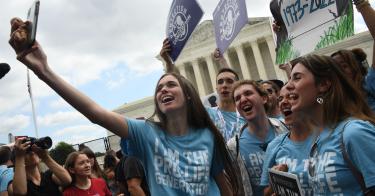It is a “very bad decision,” wrote the Yale law professor and abortion-rights supporter, “because it is … not constitutional law and gives almost no sense of an obligation to try to be.” A University of Pennsylvania law professor, who similarly supports legal abortion, wrote that the decision “is barely coherent” and “pulled … from the constitutional ether.”
These scholars were not blasting the Supreme Court’s June 24 decision in Dobbs v. Jackson Women’s Health Organization overruling Roe v. Wade. They were denouncing Roe v. Wade itself. That decision, one of the most criticized in Supreme Court history, was wrong from the start. Its abandonment was long overdue.
Abortion, which 19th century feminist leaders consistently called “child murder,” had been increasingly restricted for 250 years when the Supreme Court intervened in 1973. Local regulations had barred midwives from causing an abortion since the early 18th century.
Led by the American Medical Association, state legislatures increasingly prohibited what physicians condemned as “the unwarrantable destruction of human life.” By 1973, nearly every state prohibited abortion except to save the mother’s life.
>>> WATCH: Tearing Us Apart: How Abortion Harms Everything and Solves Nothing
That may have been what legislatures wanted, but it wasn’t acceptable to the Supreme Court. Even though the states that ratified the 14th Amendment in 1868 also banned abortion, the Court claimed that the same 14th Amendment actually made those laws unconstitutional.
The truth is that the Court did not try very hard to interpret the Constitution; in fact, the justices didn’t much care where in the Constitution (there were five different theories floating around) anyone said abortion belonged. The Court’s aim was not to interpret the Constitution, but to impose a policy of almost unrestricted abortion because, in the justices’ personal opinion, doing otherwise would impose a “detriment” upon women.
That policy was more permissive than not only any state, but than almost any country anywhere in the world.
The Supreme Court had the chance to correct this error in 1992 but, in Planned Parenthood v. Casey, found a way to hang onto what it called the “essence” of Roe v. Wade. The Court did not say that Roe had been correctly decided; by then, almost no one even bothered to make that claim. And the Court in Casey ended up tossing Roe’s rules for evaluating state pro-life laws, writing some new rules of its own.
But the Court just could not let go of Roe’s fictional “central holding” that the Constitution, though completely silent on the subject, protects a right to abortion.
In Dobbs, however, the Court finally did the right thing. We should all want our institutions to act with integrity, and our courts to treat the Constitution seriously. That means not making up what isn’t there, and leaving what isn’t there to the people and their elected representatives.
Ours is a system of “self-government,” after all. The Constitution is the people’s rulebook for government, including the judicial branch, and the Constitution cannot control judges if it means whatever they say it means. That principle is so important that we should apply it even if it means we don’t always get what we want.
Justice Samuel Alito wrote for the Dobbs majority: “Roe was egregiously wrong from the start. Its reasoning was exceptionally weak, and the decision has had damaging consequences.” No one should want a Supreme Court decision that can be described that way to remain on the books, no matter its subject. Speaking of that, however, nearly 60% of Americans under the age of 30 don’t even know that Roe was about abortion.
Large and consistent majorities of Americans have long believed that the abortions Roe v. Wade made legal—abortions because the mother simply does not want to be pregnant—should be illegal. A 2018 Gallup poll, for example, found that a majority, even in the first trimester, said abortion should be illegal when “the woman does not want the child.”
>>> After Supreme Court’s Abortion Decision Conservatives Face a New and Even Greater Challenge
The American people, not the Supreme Court, should decide whether that should be reflected in our laws.
Both before, and since the Dobbs decision, abortion advocates have tried to undermine it by claiming that overruling Roe would necessarily puts other rights, involving such things as contraception, interracial marriage, or same-sex marriage, at risk. They must be hoping that no one will read either Roe or Dobbs, because both decisions explicitly reject that idea
In Roe, the argument was that the Court should create the right to abortion because it had created other privacy rights. Justice Harry Blackmun, who wrote the majority opinion, disagreed, writing that abortion is “inherently different” than those other rights because it involved the “unborn child.”
In Dobbs, the argument in reverse was that the Court should not overrule Roe because it would undermine those other privacy rights. Once again, the Court held that “abortion is fundamentally different” because it destroys a human being. “Nothing in this opinion,” wrote Alito, “should be understood to cast doubt on precedents that do not concern abortion … It is hard to see how we could be clearer.”
The two most important issues here are that the right to abortion came from the Supreme Court, not the Constitution, and that abortion destroys a living human being. The Supreme Court has corrected the first error so that legislatures are free to correct the second.
This piece originally appeared in the Daily Caller




